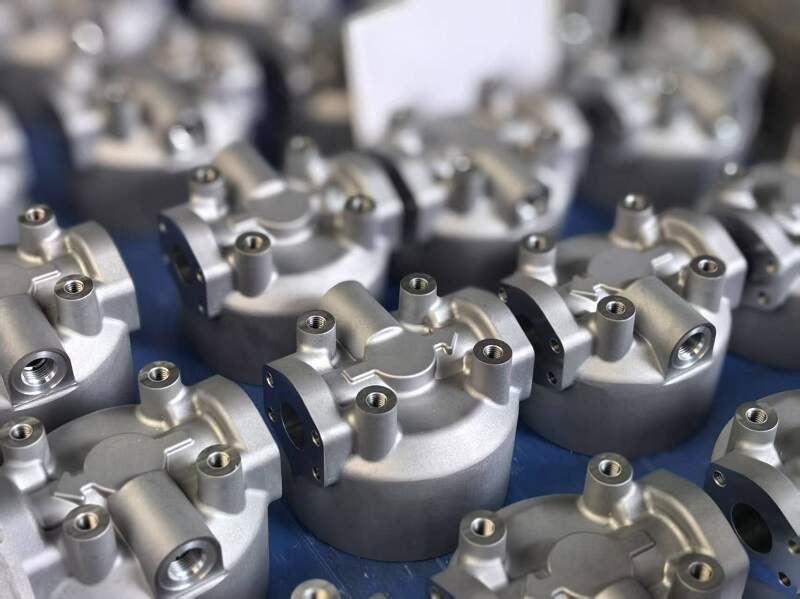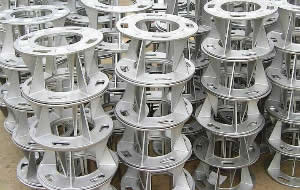Innovations Driving Precision aluminum casting Technology
Wiki Article
Aluminum Casting Explained: Key Facts and Insights for Industry Professionals
Aluminum casting works as an essential process in modern-day manufacturing, shaping components throughout numerous sectors. Its varied methods, such as sand and die casting, deal with different manufacturing needs. The unique residential properties of aluminum alloys improve their applicability, yet tests remain in preserving quality and performance. Recognizing these aspects is necessary for industry professionals. What are the most recent improvements and ideal methods that can better maximize this process?Introduction of Aluminum Casting Processes

Key aspects of aluminum casting procedures consist of the prep work of mold and mildews, which may be made from sand, steel, or ceramic products, depending on the meant usage. Furthermore, temperature control is important to assure appropriate melting and solidification of aluminum.
The casting process permits elaborate designs and can achieve high degrees of dimensional precision. Once cooled down, the castings may go through completing operations such as machining or surface area treatment to fulfill certain efficiency requirements. Generally, aluminum casting acts as a flexible manufacturing method, effectively fulfilling the diverse requirements of numerous sectors.
Types of Aluminum Casting Techniques
In the domain of aluminum casting, different methods are employed to accomplish various results. Sand casting strategies offer versatility and cost-effectiveness for complicated shapes, while die casting processes provide high accuracy and performance for mass manufacturing. Recognizing these methods is essential for choosing the suitable approach based on project needs.Sand Casting Strategies
Sand casting methods stand for a fundamental method in aluminum casting, where sand is utilized as a mold product to form liquified steel. This procedure entails creating a pattern from the desired component, which is after that put in a sand mixture to develop a mold. The sand is compressed around the pattern, and after elimination, it develops a tooth cavity in the shape of the part. Molten aluminum is put into this tooth cavity, allowing it to cool and solidify. One considerable benefit of sand casting is its flexibility; it can accommodate big components and complex shapes. Additionally, the materials made use of are relatively economical, making it an available alternative for different manufacturing applications in the aluminum industry.Die Casting Processes
Die casting processes are a popular technique for shaping aluminum components, using high-pressure strategies to compel molten metal into precisely engineered mold and mildews. This process is specifically favored for its capacity to generate complex forms with limited tolerances and a smooth surface. There are 2 key kinds of die casting: warm chamber and cold chamber. Hot chamber die casting is ideal for metals with low melting points, allowing for faster production rates. Conversely, chilly chamber die casting is perfect for higher melting factor steels, requiring a different melting heating system. Both methods improve efficiency and decrease material waste, making them important in automotive, aerospace, and customer items markets. Recognizing these processes helps professionals pick the most suitable strategy for their specific applications.Product Properties of Aluminum Alloys

Toughness and Longevity
Toughness and longevity are important qualities of aluminum alloys that make them suitable for numerous casting applications. These products exhibit a desirable strength-to-weight proportion, enabling for the production of light-weight yet robust elements. With respect to tensile toughness, certain aluminum alloys can be crafted to endure substantial loads without deforming. This residential or commercial property is specifically important in sectors such as aerospace and vehicle, where performance and safety are vital. Furthermore, aluminum alloys usually keep their mechanical residential or commercial properties under diverse temperature conditions, making sure constant performance. The innate ductility of these alloys additionally permits reliable shaping during the casting process, making it simpler to generate intricate geometries. On the whole, the toughness and resilience of aluminum alloys contribute greatly to their prevalent usage in advanced applications.Corrosion Resistance Characteristics
While aluminum alloys are treasured for their strength and light-weight residential properties, their corrosion resistance is another vital feature that improves their suitability for numerous applications. Aluminum naturally creates a protective oxide layer when subjected to wetness, which helps to stop additional oxidation. This inherent building makes aluminum alloys particularly valuable in environments prone to rust, such as commercial and aquatic settings. In addition, different alloy make-ups can influence resistance levels, with particular alloys particularly engineered to boost this particular. Therapies like plating can even more boost deterioration resistance by thickening the oxide layer. Consequently, recognizing the deterioration resistance of aluminum alloys is essential for industry professionals when selecting products for projects requiring durability and longevity in difficult environments.Advantages of Aluminum Casting in Manufacturing
Aluminum casting deals numerous advantages in manufacturing, making it a recommended selection for various sectors. One considerable advantage is its light-weight nature, which contributes to lowered transportation costs and improved energy performance in output. Furthermore, aluminum's outstanding thermal and electrical conductivity improves capability in applications requiring warm dissipation or electrical conduction.The material's capability to be cast into detailed forms allows for layout adaptability, reducing the requirement for additional machining processes. On top of that, aluminum casting shows exceptional deterioration resistance, leading to longer product life-spans and reduced upkeep expenses.

Typical Applications of Aluminum Castings
The adaptability of aluminum casting allows its prevalent use throughout numerous industries. Typical applications consist of auto components, where light-weight and corrosion-resistant components, such as engine blocks and transmission real estates, improve lorry efficiency. In the aerospace industry, aluminum castings are used for architectural parts, offering stamina without adding considerable weight.
Additionally, the electrical industry take advantage of aluminum castings in manufacturing enclosures and warm sinks, where thermal conductivity is vital. The customer goods field additionally incorporates aluminum spreadings in products like kitchenware, furnishings, and attractive items, integrating looks with functionality.
In addition, the building and construction sector uses aluminum castings for architectural components, window frames, and fixtures, which give sturdiness and style flexibility. On the whole, the diverse applications of aluminum castings underscore their relevance in modern-day production, adding to innovations in efficiency and item layout throughout multiple fields.
Technologies and Technological Innovations
As sectors proceed to evolve, technologies in aluminum casting technology are transforming production procedures and product capacities. Advancements in 3D printing and additive manufacturing have actually allowed the creation of complicated geometries that were formerly difficult to attain with conventional methods. These modern technologies enable rapid prototyping, reducing preparations and costs.In addition, enhancements in mold and mildew style and products have actually boosted the casting procedure by increasing efficiency and lowering waste. The combination of smart manufacturing methods, such as IoT gadgets and real-time data analytics, permits for better monitoring and optimization of production specifications, leading to better outputs.
Developments in aluminum alloys give enhanced strength, rust resistance, and light-weight residential or commercial properties, catering to the expanding needs in automotive and aerospace markets. Collectively, these innovations are not only enhancing performance however likewise meeting the extensive requirements of contemporary engineering applications.
Best Practices for Quality Assurance in Aluminum Casting
Making sure top notch outcomes in aluminum casting calls for adherence to ideal methods that include numerous stages of the production procedure. Initially, thorough material examination is important to confirm the quality of aluminum alloys made use of, as impurities can greatly influence the final product. Applying exact melting and pouring strategies decreases issues; keeping perfect temperature levels protects against oxidation and advertises uniformity.Mold layout plays an important duty; using computer-aided style (CAD) can boost precision and reduce human mistake. Normal monitoring of the cooling procedure is critical to prevent bending and shrinkage. Additionally, using non-destructive testing approaches, such as ultrasonic or X-ray examinations, helps identify interior imperfections without harming the elements.
Establishing a feedback loop with operators and engineers fosters continual renovation, making sure that top quality control actions develop alongside technological developments. By following these ideal methods, producers can improve the reliability and performance of aluminum castings.
Regularly Asked Concerns
What Are the Environmental Impacts of Aluminum Casting?
The ecological effects of aluminum casting include significant power intake, greenhouse gas discharges, and prospective water air pollution from foundry operations. In addition, bauxite mining for aluminum ore can bring about environment damage and soil deterioration.How Does Aluminum Casting Compare to Other Steel Casting Processes?
Aluminum casting normally provides advantages in light-weight elements and corrosion resistance compared to various other processes, such as iron or steel casting, which might supply greater stamina however lead to much heavier and much less corrosion-resistant products. - aluminum castingWhat Prevail Problems in Aluminum Castings and Their Reasons?
Usual problems in aluminum spreadings consist of porosity, shrinkage, and incorporations. Reasons typically originate from inappropriate pouring techniques, inadequate mold and mildew layout, or contamination of the molten metal, influencing the last item's honesty and efficiency.What Safety Safety Measures Should Be Taken Throughout Aluminum Casting?
During aluminum casting, crucial safety and security precautions consist of wearing protective gear, guaranteeing appropriate air flow, maintaining a clean office, handling liquified metal with care, and following recognized methods to minimize threats of burns, breathing hazards, and accidents.Just How Can I Boost the Efficiency of My Aluminum Casting Workflow?
To enhance performance in aluminum casting procedures, one should Precision aluminum casting maximize mold style, simplify product handling, employ automated procedures, conduct routine maintenance on devices, and purchase employee training to enhance abilities and productivity.Numerous methods exist, aluminum casting incorporates a number of primary processes that cater to different applications and demands. Secret components of aluminum casting procedures consist of the prep work of mold and mildews, which may be made from sand, steel, or ceramic materials, depending on the intended use. Sand casting techniques stand for a basic approach in aluminum casting, where sand is made use of as a mold and mildew material to shape liquified steel. As markets proceed to progress, innovations in aluminum casting innovation are changing manufacturing processes and product abilities. Making sure premium results in aluminum casting needs adherence to best methods that include numerous stages of the manufacturing process.
Report this wiki page